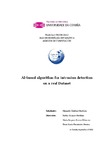AI-based algorithm for intrusion detection on a real Dataset
Title
AI-based algorithm for intrusion detection on a real DatasetAuthor(s)
Directors
Guijarro-Berdiñas, BerthaAlonso-Betanzos, Amparo
Hernández-Pereira, Elena
Date
2023Center/Dept./Entity
Universidade da Coruña. Facultade de InformáticaDescription
Traballo fin de grao (UDC.FIC). Enxeñaría Informática. Curso 2022/2023Abstract
[Abstract]: In this Project, Novel Machine Learning proposals are given to produce a Network Intrusion
Detection System (NIDS). For this, a state of the art Dataset for Cyclo Stationary NIDS has
been used, together with a previously proposed standard methodology to compare the results
of different models over the same Dataset. An extensive research has been done for
this Project about the different Datasets available for NIDS, as has been done to expose the
evolution and functioning of IDSs.
Finally, experiments have been made with Outlier Detectors, Ensemble Methods, Deep
Learning and Conventional Classifiers to compare with previously published results over the
same Dataset and with the same methodology. The findings reveal that the Ensemble Methods
have been capable to improve the results from prior research being the best approach the
Extreme Gradient Boosting method. [Resumen]: En este Proyecto, se presentan novedosas propuestas de Aprendizaje Automático para
producir un Sistema de Detección de Intrusos en Red (NIDS). Para ello, se ha utilizado un
Dataset de última generación para NIDS Cicloestacionarios, junto con una metodología estándar
previamente propuesta para comparar los resultados de diferentes modelos sobre el
mismo Dataset. Para este Proyecto se ha realizado una extensa investigación sobre los diferentes
conjuntos de datos disponibles para NIDS, así como se ha expuesto la evolución y
funcionamiento de los IDSs.
Por último, se han realizado experimentos con Detectores de Anomalias, Métodos de
Conjunto, Aprendizaje Profundo y Clasificadores Convencionales para comparar con resultados
previamente publicados sobre el mismo Dataset y con la misma metodología. Los resultados
revelan que los Métodos de Conjunto han sido capaces de mejorar los resultados de
investigaciones previas siendo el mejor enfoque el método de Extreme Gradient Boosting.
Keywords
Machine learning
Intrusion detection system
Ensemble methods
Computer network attacks
Deep learning
Outlier detection
Aprendizaje automático
Sistema de detección de intrusiones
Métodos de cojunto
Ataques de redes de computadoras
Aprendizaje profundo
Detección de anomalías
Intrusion detection system
Ensemble methods
Computer network attacks
Deep learning
Outlier detection
Aprendizaje automático
Sistema de detección de intrusiones
Métodos de cojunto
Ataques de redes de computadoras
Aprendizaje profundo
Detección de anomalías
Rights
Atribución-NoComercial 3.0 España







